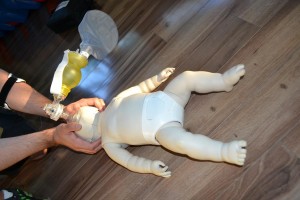Cardiac disease in children

When children get a heart attack, it is very different that when it happens to an adult. When adults get heart attacks, it is most likely due to a lifestyle-influenced heart condition like coronary artery disease (CAD). The coronary arteries are blood vessels that supply the heart with oxygenated blood to keep it functioning adequately. In CAD, these arteries become blocked with a build-up of plaque, a condition called atherosclerosis. Atherosclerosis can happen to different vessels in the body, not just the coronary arteries. A combination of plaque build up and persistent hypertension can cause the vessel to completely narrow and stop the flow of blood to the cardiac muscle. When the heart stops beating, that is called cardiac arrest.
However, this doesn’t happen when children get cardiac arrests. Heart attacks in children, especially infants and toddlers, is primarily a complication of respiratory failure. The cascade of symptoms that follow respiratory distress place a great burden on the heart; stress that an immature heart cannot take. It is after ARF (acute respiratory failure) that the heart stops working. This is called asphyxial arrest, or cardiac arrest in children. More often than not, non-respiratory cardiac arrests are caused by congenital heart diseases (CHD).
CPR for children: infants, toddlers, pre-schoolers, and school-age children
Like all other medical management techniques, giving children CPR is also different from giving CPR to an adult. There is less force used when giving CPR to children, as well as different priorities in terms of compression and ventilation.
- When chest compressions are performed on adults, the chest should be depressed by at least 2 inches. In very young and very small children, the chest should be depressed by a third of its anterior-posterior diameter, which usually falls along 1.5 inches. Be sure to allow the chest to recoil before giving another compression.
- Ventilation in children is just as important as compressions. In adults, tissue hypoxia is not caused by low oxygen content in the blood but rather poor circulation, making chest compressions a higher priority. In children, it is a different case. Tissue hypoxia is caused by both respiratory and circulatory problems, meaning compression and ventilations both become the number one priority.
- Compression and ventilation ration remains the same in both children and adults, 30:2 for one cycle.
- If a defibrillator is available when the victim is experiencing arrhythmia, attach one pad to the center of the chest and listen to the machine’s instructors. In adults, two pads are used, placed perpendicular to each other (or depending on the AEDs’ instructions)
PALS training
Located in six training locations, our Pediatric Advanced Life Support program runs over two days in 14 hours. Re-certification is also available for PALS rescuers, lasting 6 hours and 20 minutes or 8 hours and 20 minutes. Certificates expire after two years but are renewable through PALS re-certification. You may only apply to a re-certification class if your certificate is still valid; if not, you have to take the PALS program again.
